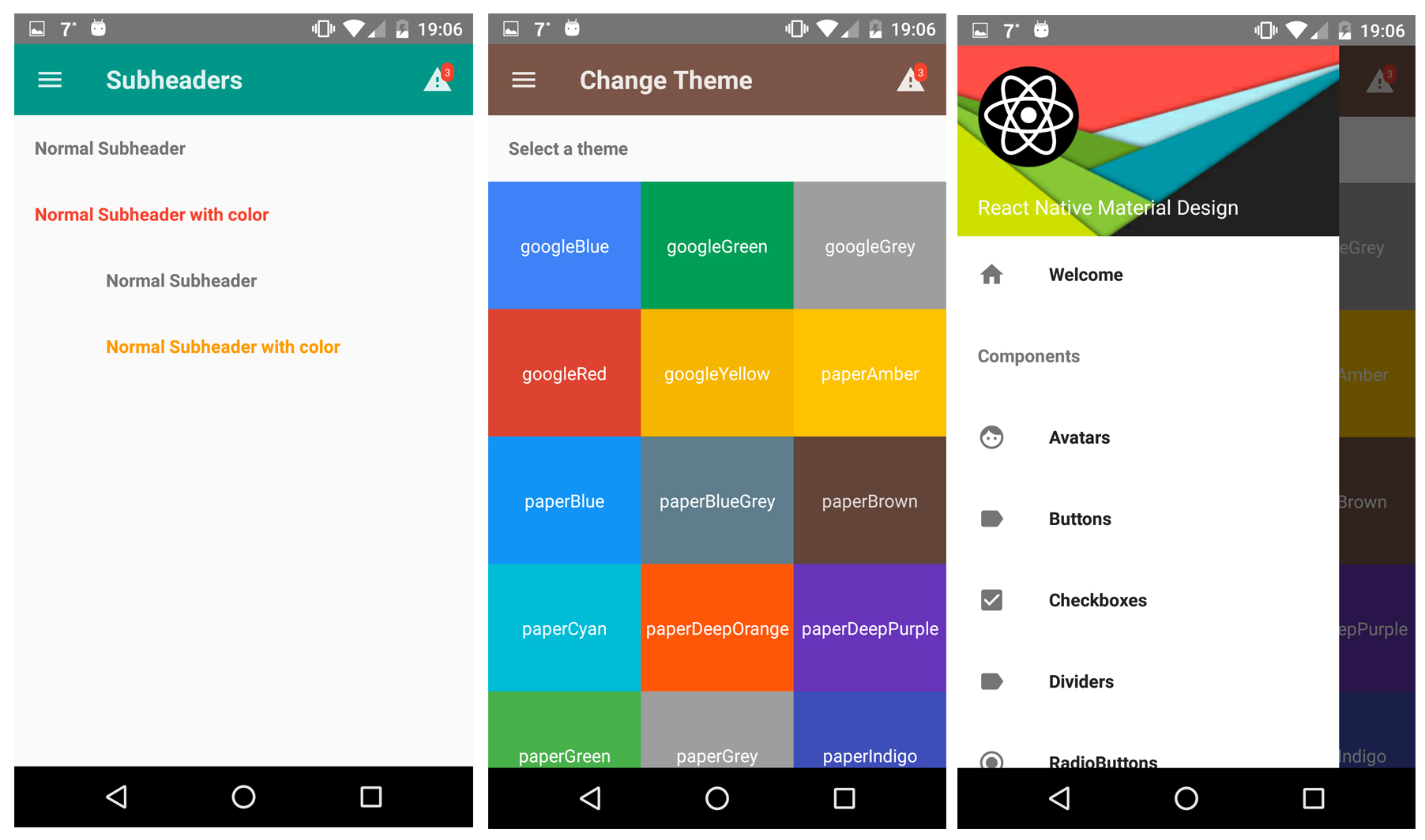react-native-mui
v11.14.0
Published
React Native Material Design Components
Downloads
23
Readme
React Native Material UI (iOS and Android supported)
Highly customizable material design components for React Native!
Getting Started
$ npm i react-native-mui --saveSetting of vector icons
You can see this repo for much more information.
React Native Link (recommended)
Make sure you have atleast v0.31.0 react-native version.
$ react-native link react-native-vector-iconsManual Installation
Android (see original)
Copy the MaterialIcons font file from react-native-vector-icons to your local working directory:
./node_modules/react-native-vector-icons/Fonts/MaterialIcons.ttf -> ./android/app/src/main/assets/fonts.
iOS (see original)
Adding Roboto Font
This project uses Roboto as the main font for text. Make sure to add Roboto to your project, as it will give the following error on iOS.
Unrecognized font family Roboto.
You can obtain Roboto free from here.
Here is a great tutorial which shows how to add custom fonts.
Usage
To achieve the level of customizability, React Native Material UI is using a single JS object called uiTheme that is passed in via context. By default, this uiTheme object is based on the lightTheme that you can find here. So, you can change almost everything very easily.
The uiTheme object contains the following keys:
spacing: {} // can be used to change the spacing of components.
fontFamily: {} // can be used to change the default font family.
palette: { // can be used to change the color of components.
primaryColor: blue500,
accentColor: red500,
...
}
typography: {} // can be used to change the typography of components
// you can change style of every each component
avatar: {}
button: {}
toolbar: {}
...import React, { Component } from 'react';
import { Navigator, NativeModules } from 'react-native';
import { COLOR, ThemeProvider } from '../react-native-mui';
// you can set your style right here, it'll be propagated to application
const uiTheme = {
palette: {
primaryColor: COLOR.green500,
},
toolbar: {
container: {
height: 50,
},
},
};
class Main extends Component {
render() {
return (
<ThemeProvider uiTheme={uiTheme}>
<App />
</ThemeProvider>
);
}
}It means, if you want to change primary color of your application for example. You can just pass to ThemeProvider object with your own settings. Your settings will be merged with default theme.
What else?
Another great feature is, you can use the uiTheme everywhere. Even in your own components. So if you built your own implementation of Button for example, look how you can get the primary color.
import ...
const contextTypes = {
uiTheme: PropTypes.object.isRequired,
};
class MyButton extends Component {
render() {
// it's really easy to get primary color everywhere in your app
const { primaryColor } = this.context.uiTheme.palette;
return ...
}
}
export ...Local changes
Of course, sometimes we need to change style of only one component. It means, all buttons have red background, but facebook login button that should have blue background. Every each component have style property. So you can very easily override whatever you want.
<Button style={{ container: { backgroundColor: 'blue' }}} />Animations are included
Note: You have to allow the animations for Android (see React Native's documentation)
UIManager.setLayoutAnimationEnabledExperimental &&
UIManager.setLayoutAnimationEnabledExperimental(true);Themes are supported
Toolbar with search feature
Examples
You can try our Demo App!



Components
Here is a list of all component included in this library. (I'm working on documentation for every each component. Be patient please :))
- Action Button
- Avatar
- Badge
- Bottom Navigation
- Button
- Card
- Checkbox
- Dialog
- Divider
- Drawer
- Icon
- Icon toggles
- List item
- Radio button
- Subheader
- Toolbar




